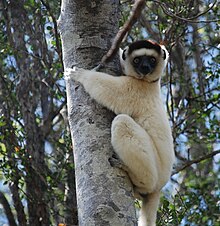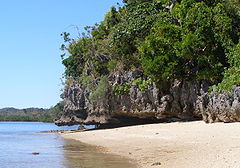
The Madagascar lowland forests or Madagascar humid forests are a tropical moist broadleaf forest ecoregion found on the eastern coast of the island of Madagascar, home to a plant and animal mix that is 80 to 90% endemic, with the forests of the eastern plain being a particularly important location of this endemism. They are included in the Global 200 list of outstanding ecoregions.

The Madagascar subhumid forests are a tropical moist broadleaf forest ecoregion that covers most of the Central Highlands of the island of Madagascar. They are included in the WWF's Global 200 list of outstanding ecoregions. Most of the original habitats have been lost due to human pressure.

Ankarana Special Reserve is a protected area in northern Madagascar created in 1956. It is a small, partially vegetated plateau composed of 150-million-year-old middle Jurassic limestone. With an average annual rainfall of about 2,000 millimetres (79 in), the underlying rocks have been eroded to produce caves and feed subterranean rivers—a karst topography. The rugged relief and the dense vegetation have helped protect the region from human intrusion.

Morondava is a city located in Menabe Region, of which it is the capital, in Madagascar. It is located in the delta of the Morondava River at 20°17′5″S44°19′3″E. Its population as of the 2018 census, was 53,510.
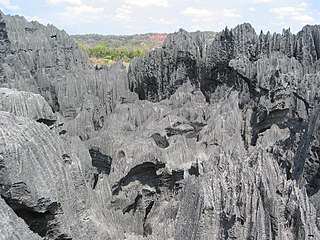
Tsingy de Bemaraha Strict Nature Reserve is a nature reserve located near the western coast of Madagascar in Melaky Region. The area was listed as a UNESCO World Heritage Site in 1990 due to the unique geography, preserved mangrove forests, and wild bird and lemur populations.
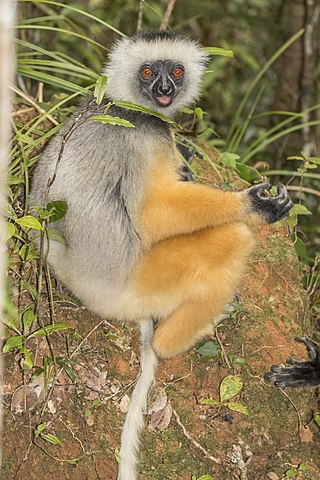
The diademed sifaka, or diademed simpona, is an endangered species of sifaka, one of the lemurs endemic to certain rainforests in eastern Madagascar. Along with the indri, this species is one of the two largest living lemurs, with an average weight of 6.5 kg and a total adult length of approximately 105 centimetres (41 inches), half of which is its tail. Russell Mittermeier, one of the contemporary authorities on lemurs, describes the diademed sifaka as "one of the most colorful and attractive of all the lemurs", having a long and silky coat. P. diadema is also known by the Malagasy names simpona, simpony and ankomba joby. The term "diademed sifaka" is also used as a group species designation formerly encompassing four distinct subspecies.

The Anjajavy's Protected Area is located on a peninsula of the town of Antonibe, in the district of Analalava and in the north-west region of Madagascar. It is part of the Sofia region of the independent province of Mahajanga and its position is between 47°13’ at 44°22’ of longitude east and 14°58 at 15°07’ of latitude south..

Berenty Reserve is a small private reserve, near Amboasary Sud, Anosy. It is situated along the Mandrare River, set in the semi-arid spiny forest ecoregion of the far south of Madagascar. For more than three decades the late primatologist Alison Jolly, other researchers and students have visited Berenty to conduct fieldwork on lemurs. The reserve is also a favourite for visitors who want to see some of Madagascar's endemic bird species, which include owls and couas.

The Montagne des Français Reserve is a protected area consisting principally of dry deciduous forest in northern Madagascar. It is part of the larger Ramena protected area complex which also includes Orangea Reserve and the Ambodivahibe Marine Reserve. These three protected areas are currently being created and will be designated in 2008.

The Kirindy Mitea National Park is a national park on the coast of the Mozambique Channel, in south-west Madagascar. The 72,200 hectares park contains many endemic animals and plants and claims to have the greatest density of primates in the world.

Tsimanampetsotsa National Park also spelt Tsimanampetsotse, and known as Tsimanampetsotsa Nature Reserve is a 432 km2 national park on the south-west coast of Madagascar in the region Atsimo-Andrefana. The park is 90 kilometres (56 mi) south of Toliara and 950 kilometres (590 mi) south of the capital, Antananarivo. Route Nationales (RN) 10 to Faux Cap passes the park and the nearest airport is at Toliara. The national park contains and is named after Lake Tsimanampetsotsa.
Analamerana Special Reserve is a 347 square kilometres (134 sq mi) wildlife reserve in the north of Madagascar. The reserve was created in 1956 to protect its endemic plants and animals, such as the critically endangered Perrier's sifaka, which is considered to be one of the most endangered primates in the world.

Andranomena Special Reserve is a wildlife reserve in Menabe Region, western Madagascar, near the city of Morondava and the rural commune of Bemanonga.
Ambatovaky Special Reserve is a tropical rainforest and wildlife reserve in the north-east of Madagascar. It is designated by Bird Life International as an Important Bird Area for the large number of endemic species of birds.
Maningoza Special Reserve is a 9,826 hectares wildlife reserve near Besalampy in Madagascar. It was created in 1956 to protect the many endemic plants and animals, and it also contains some of the last remaining areas of dry deciduous forest on the island.

Perrier's sifaka is a lemur endemic to Madagascar. It was formerly considered to be a subspecies of diademed sifaka It has a very small range in northeastern Madagascar where its habitat is dry deciduous or semihumid forest. Part of its range is in protected areas. It is an almost entirely black sifaka and measures about 90 cm (35 in), half of which is a bushy tail. Females are slightly larger than males.

The Tsingy de Bemaraha National Park is a national park located in northwest Madagascar. It is mainly within the boundaries of Antsalova District, with a small part in the northeast falling within Morafenobe District. The national park centers on two geological formations: the Great Tsingy and the Little Tsingy. Together with the adjacent Tsingy de Bemaraha Strict Nature Reserve, the National Park is a UNESCO World Heritage Site.
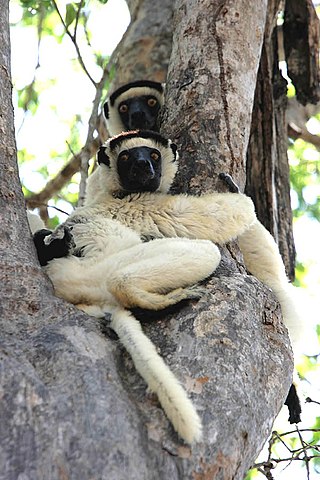
The Kirindy Forest is a private nature reserve situated in western Madagascar, about 50 km northeast of the town of Morondava, near Ambivy. The forest reserve falls within the boundaries of the Kirindy Mitea National Park, which spreads further to the south.

The Madagascar succulent woodlands are a xeric shrublands ecoregion in southwestern and central western Madagascar. Native plants survive in the arid climate and long dry season with adaptations like succulent leaves, water storing trunks, photosynthetic stems, and dropping leaves during the dry season. The ecoregion is threatened by various human activities.

Loky-Manambato is a protected area near Daraina in northern Madagascar, in the northern part of the Vohemar District. It is located in northern Sava Region, bounded on the north by the Loky River, on the south by the Manambato River, and on the east by the Indian Ocean. In its center flows the Manankolana river.


